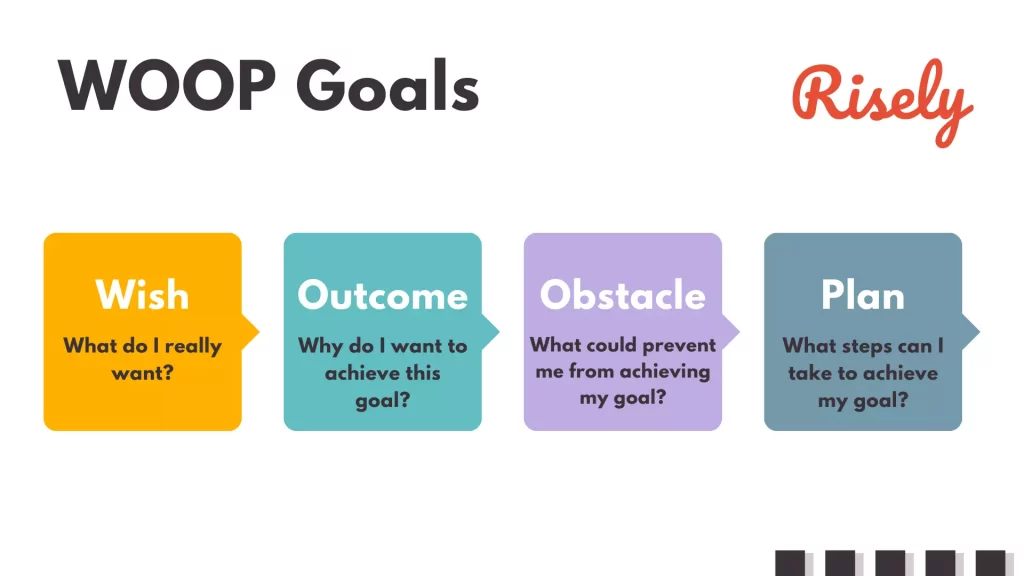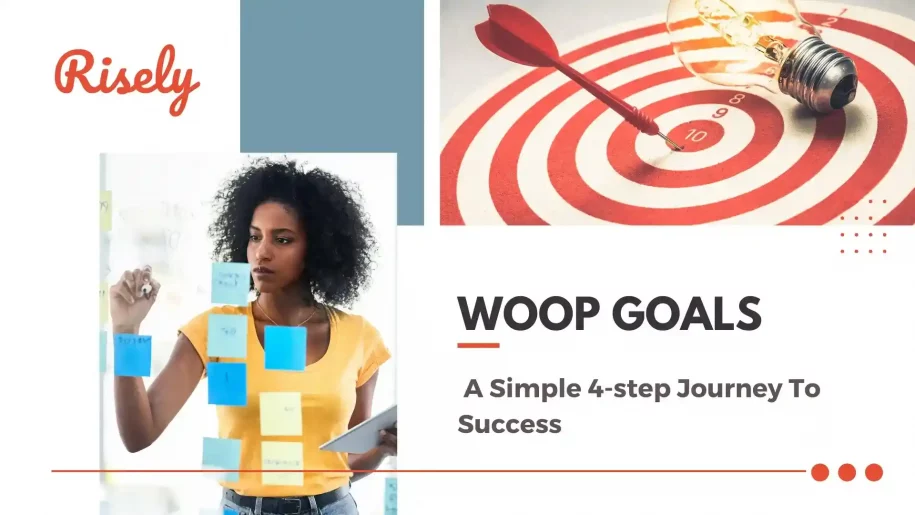WOOP Goals: A Simple 4-step Journey To Success
“I want to be happier and more successful in my career.” “I want to lose weight and look better.” “I want to stop procrastinating and start working on my goals.” “I want to be able to make decisions that are best for me and not others.” “I want to learn a new skill so that I can improve myself as an individual and my job prospects.” These are all great intentions, but making them into reality is much more challenging than it seems. As psychotherapist Kirsten Sandberg, life often gets in the way of our goals. The obstacles we face, whether external or internal, can derail us from our desired direction of progress. In this blog post, we will discuss the science behind WOOP (the goal-setting technique) and how you can use it to help you achieve your goals today!What are WOOP Goals?
WOOP, or ‘Wish, Outcome, Obstacle, and Plan,’ is a positive thinking technique proven effective in setting goals. Unlike SMART goals (Specific, Measurable, Attainable, and Time-bound), WOOP focuses on inner obstacles rather than tangible goals. This method involves setting intentions at the beginning of a goal-setting session. By thinking about what you want to achieve and then thinking about obstacles that could get in the way of your goal, you can figure out how to overcome them. Once you have clearly articulated your goal and obstacles, creating a plan for achieving your goals is more effortless.WOOP Goals in 4 Steps
WOOP is an acronym for Wish, Outcome, Obstacle, and Plan. It’s a goal-setting technique developed by Dr. Gabrielle Oettingen, a professor of psychology at New York University. The WOOP technique is based on scientific goal-setting, motivation, and visualization research. It is designed to help individuals set and achieve their goals more effectively.
Step 1: WISH
The first step in creating WOOP goals is to identify your wish, which is your ultimate goal. This step involves asking yourself, “What do I really want?” and determine what you most want to achieve. When completing this step, it can be helpful to consider the following questions:- What would make me happiest or most fulfilled?
- What do I really care about?
- What is the most important thing I want to achieve right now?
Step 2: OUTCOME
The second step in the WOOP technique is identifying the positive outcome of achieving your goal. This step involves asking yourself, “Why do I want to achieve this goal?” and determining what will make achieving your goal worthwhile. When completing this step, it can be helpful to consider the following questions:- What will be the benefits of achieving my goal?
- What positive feelings or experiences will I have when I reach my goal?
- How will achieving my goal improve my life?
Step 3: OBSTACLE
The third step in creating WOOP goals is to identify the obstacles that stand in your way. This step involves asking yourself, “What is preventing me from achieving my goal?” and identifying the things that might hinder your success. When completing this step, it can be helpful to consider the following questions:- What challenges or barriers might I face when trying to achieve my goal?
- What are the biggest obstacles that stand in my way?
- What could prevent me from achieving my goal?
Step 4: PLAN
The final step in the WOOP technique is to create a plan for overcoming the obstacles and achieving your goal. This step involves asking yourself, “What steps can I take to achieve my goal?” and creating a concrete plan for taking action. When completing this step, it can be helpful to consider the following questions:- What specific actions can I take to overcome the obstacles I’ve identified?
- What resources do I need to achieve my goal?
- What steps will I take to measure my progress and track my success?
Other Interesting Reads
What Science Says about WOOP Goals
The science behind WOOP goals is based on research in psychology. Specifically, it is based on goal-setting, motivation, and visualization research. One of the key findings from this research is that more than simply setting a goal is needed to ensure success. Instead, it is crucial also to consider the potential obstacles that might stand in the way of achieving the goal and to create a plan for overcoming them. Another key finding is that visualization can be a powerful tool for achieving goals. By visualizing oneself overcoming obstacles and achieving the desired outcome, you can increase motivation and improve your chances of success. The WOOP goals combines these two principles by encouraging individuals to identify their Wish, Outcome, Obstacle, and Plan. By doing so, you are forced to consider both the positive and negative aspects of their goals and to create a concrete plan for overcoming obstacles and achieving success. Additionally, the WOOP goals approach encourages you to engage in mental contrasting, which involves visualizing both the positive outcomes of achieving the goal and the potential obstacles that may stand in the way. Research has shown that the WOOP goals approach can be effective in helping individuals achieve their goals. For example, a study was conducted by researchers at New York University and the University of Konstanz, which found that participants who used the WOOP approach to set and achieve goals related to unhealthy dietary behavior were more successful than those who set goals without considering potential obstacles or creating a concrete plan for overcoming them. Specifically, participants who used the WOOP goals approach were more likely to consume fewer calories and make healthier food choices. Overall, the science behind WOOP goals highlights the importance of considering both the positive and negative aspects of goal-setting and creating a concrete plan for overcoming obstacles and achieving success. Check out Drive Your Goals With Goal Pyramids: Unveiling the Path to Success for another interesting perspective on goal-setting.5 WOOP Goals Examples for Managers
Here are five examples of WOOP goals that you can use in the workplace:Better Communication
- Wish: I want to become a better communicator with my team.
- Outcome: If I improve my communication skills, I will build better relationships with my team and be more effective.
- Obstacle: I need help with public speaking and often get nervous when speaking in front of others.
- Plan: I will sign up for a public speaking course, practice giving presentations to small groups, and seek feedback from my colleagues to improve my communication skills.
Increase in productivity
- Wish: I want to increase my productivity and get more done in less time.
- Outcome: If I become more productive, I can take on more responsibilities and achieve better results in my work.
- Obstacle: I get easily distracted by social media and other non-work-related tasks.
- Plan: I will create a daily to-do list, prioritize my tasks based on importance, and use time-blocking techniques to minimize distractions and stay focused.
Improved leadership
- Wish: I want to improve my leadership skills and become a better manager.
- Outcome: If I become a better leader, I can motivate and inspire my team and achieve better results for the organization.
- Obstacle: I need help delegating tasks and often feel I need to do everything myself.
- Plan: I will identify tasks that can be assigned to others, communicate my expectations clearly, and provide support and feedback to my team to help them succeed.
Better work-life balance
- Wish: I want to improve my work-life balance and avoid burnout.
- Outcome: If I achieve a better work-life balance, I will be happier and more productive at work and home.
- Obstacle: I often feel guilty for taking time off or setting boundaries with my work.
- Plan: I will schedule regular breaks throughout the day, set realistic goals and expectations, and clearly communicate my boundaries with my colleagues and manager.
Learning new skill
- Wish: I want to develop a new skill that will help me advance in my career.
- Outcome: If I learn a new skill, I can take on new challenges and opportunities in my work.
- Obstacle: I need more time to learn a new skill outside my work hours.
- Plan: I will identify resources for learning the new skill, such as online courses or workshops, and schedule weekly time to build my knowledge and expertise in this area. I will also seek feedback and support from my colleagues and manager to help me stay on track and achieve my goals.
Conclusion
In conclusion, the WOOP goals method provides a simple yet effective framework for achieving your goals. By breaking them down into manageable steps and addressing potential obstacles, you can increase motivation, improve decision-making, and ultimately lead a more fulfilled life. By practicing the WOOP goals regularly, you can cultivate a mindset that empowers you to turn your wishes into tangible outcomes. Remember to keep your goals realistic and remain flexible in your approach. With the WOOP method, you have a powerful tool to help you achieve your aspirations and reach your full potential.Test the effectiveness of your goal-setting skills for free
Take the free goal-setting assessment by managers that helps managers unlock their true potential.
FAQs
What is the difference between WOOP and SMART goals?
WOOP (Wish, Outcome, Obstacle, Plan) is a goal-setting strategy that emphasizes identifying and addressing potential obstacles. SMART (Specific, Measurable, Achievable, Relevant, Time-bound) goals focus on making goals specific and measurable. While SMART focuses on criteria for effective goals, WOOP considers obstacles and planning more deeply.
When to use WOOP goal setting?
WOOP goal setting is useful when you want to not only define specific and measurable goals (like SMART) but also identify potential obstacles and create actionable plans to overcome them, enhancing goal achievement.
Other Related Blogs
How to Set Effective Learning and Development Goals?
This blog highlights how effective learning and development goals are set, why is setting them important for your organization and what challenges you might face during this process. … Read…
Are you on track to meet your Q1 goals?
Are you on track to meet your Q1 goals? We are in the middle of the first quarter of 2024. Seems hard to believe. It surely is! ⏰ Time has…
5 Secrets Of Solid Goal Setting At Work You Can’t Miss
5 Secrets Of Solid Goal Setting At Work You Can’t Miss “I don’t focus on what I’m up against. I focus on my goals and I try to ignore the…
Understanding the world of Goal Setting Coach to reach new heights
Understanding the world of Goal Setting Coach to reach new heights Setting and achieving goals is essential for personal and organizational success in today’s fast-paced and competitive work environment. However,…


